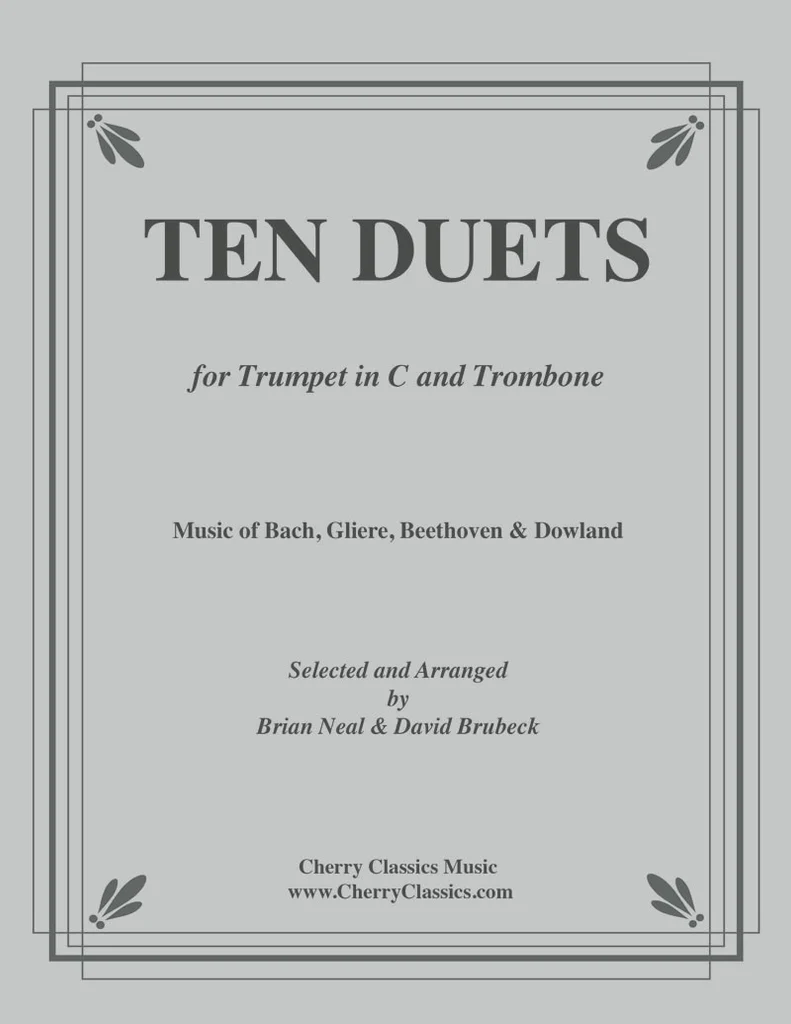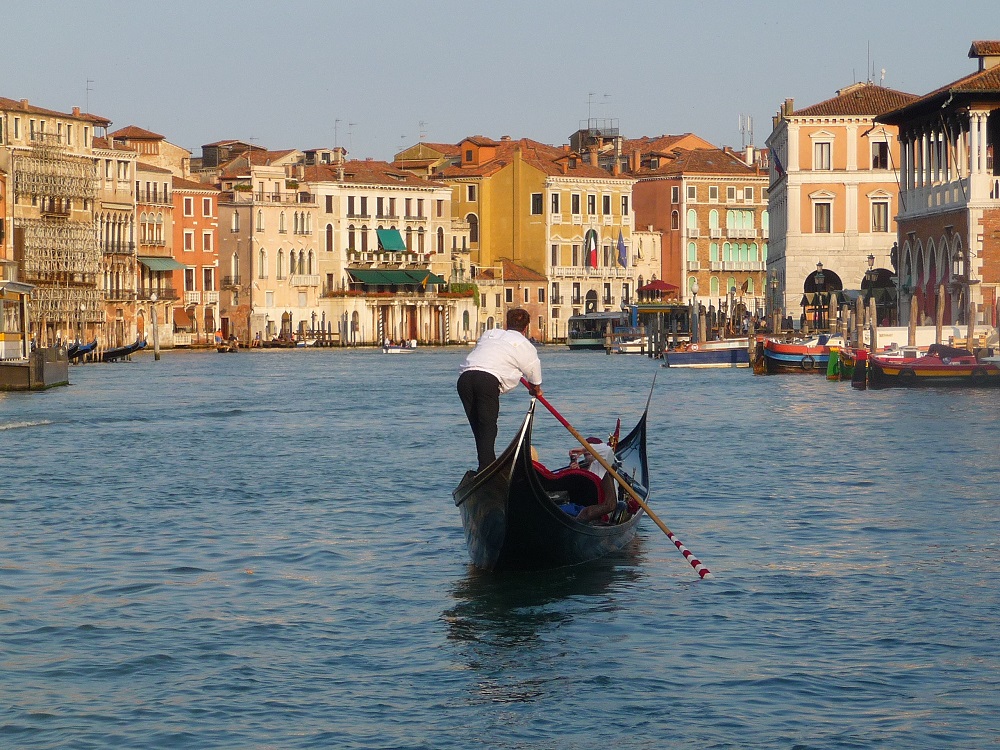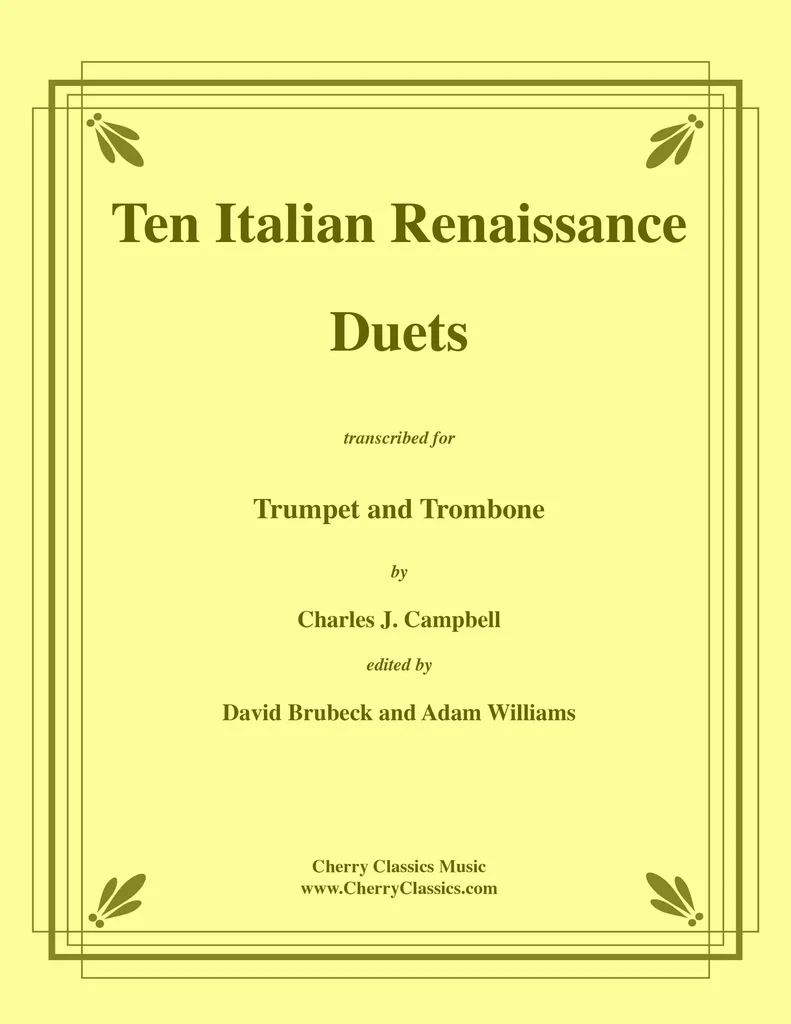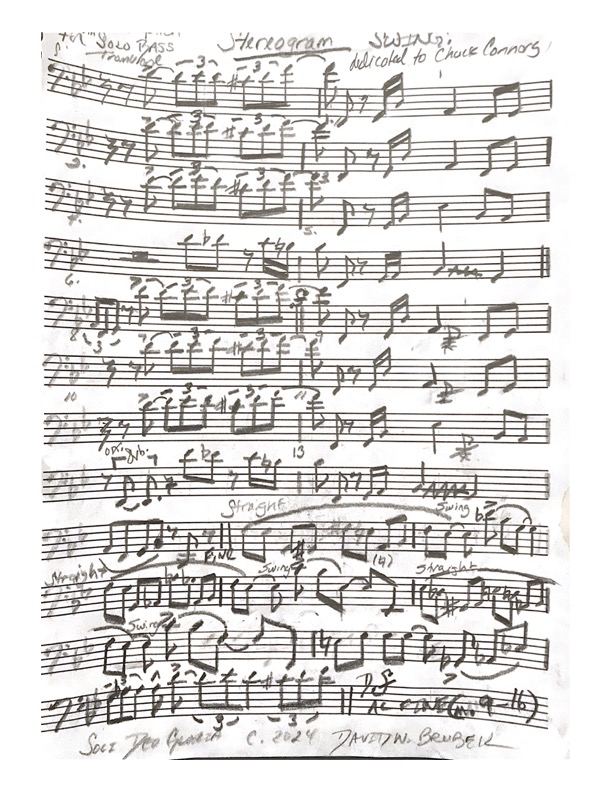
Performance notes:
Grace notes after beat 3 are; m. 7 pedal ‘A’; m. 9 pedal ‘A’; and m. 11 pedal ‘Bb’.
[ ] in m. 12 designates an optional 8vbasso, with the low ‘F’ played instead as pedal ‘F’.
Straight (eighth-note), measures include 17, 19 & 21 as well as the first beat of 18, 20 & 22. The rest is Swing!
The Del segno to Fine section is measures 9-15.
The pedal note in m. 16 is a ‘Bb’, and may be played up an octave.
ENJOY!
PS: If you play single-valve Bass Trombone-you are especially welcome!
Below is a reprint of a related article included in the davidbrubeck.com series “The Jazz Bass Trombone”, No. 2
An Interview with Marc T. Bolin, by David William Brubeck
1. How would you describe the use of the bass trombone in Duke Ellington’s orchestra? (Jazz bass trombone being defined as having a .547 bore or larger with at least one valve).
Ellington didn’t begin to utilize a large-bore trombone until 1961 with the addition of Chuck Connors. Duke always used the three trombones prior to 1963 as unique and individual voices that would blend to create a particular sound-(the sound unique for each tune that matched the sound in his mind’s ear),…and that would be determined in part by who was playing which part as this would depend on each tune. I would describe Ellington’s trombone section up until then as trombone 1, 2, and 3…not, tenor 1, 2, and bass trombone. Dig? It wasn’t until the addition of Connors that Ellington would utilize a more stereotypical sound of two tenors and a bass section sound.
2. Why did Duke seem to favor three trombones? When did he switch to four?
Moon Mist recorded in Chicago late January 1957 (track 8) utilizes 6 trombones: Lawrence Brown (tracks 1-3 & 8-17), Buster Cooper (tracks 1-3 & 8-17), Quentin Jackson (track 8), Britt Woodman (track 8) – trombone, John Sanders – valve trombone (track 8), Chuck Connors – bass trombone (tracks 1-3 & 8-17)
Ellington was back to using three bones on the Symphomaniac (Symphonic or Bust) [recorded and released on the Reprise label in 1963] is certainly a huge sound. But, that’s Ellington. Ellington was able to get a sound out of three trombones that most jazz arrangers could only get using four.
Swinging Suites by Edward E. & Edward G. (also known as Peer Gynt Suite/Suite Thursday…or “Zweet Zurzday”) Ellington recorded for the Columbia label in 1960. Ellington made use of the four-trombone sound here, too. But, curiously he only used four on the Grieg stuff – Lawrence Brown, Mathew Gee, Booty Wood, and Britt Woodman – all tenors of course.
A Concert of Sacred Music Live from Grace Cathedral and on DVD as Love You Madly/A Concert of Sacred Music at Grace Cathedral. The official album on RCA, A Concert of Sacred Music, was recorded at two concerts at Fifth Avenue Presbyterian Church in New York on December 26, 1965.
The concert premiered on September 16, 1965. (First Sacred Concert); Lawrence Brown, Buster Cooper, Quentin Jackson, Britt Woodman – trombone, John Sanders – valve trombone, Chuck Connors – bass trombone.
January 19, 1968, Ellington’s Second Sacred Concert ; Lawrence Brown, Buster Cooper, Bennie Green – tenor trombone, Chuck Connors – bass trombone.
Third Sacred Concert, October 24, 1973, Ellington was back to writing for three trombones. Art Baron, Vince Prudente – trombone, Chuck Connors – bass trombone.
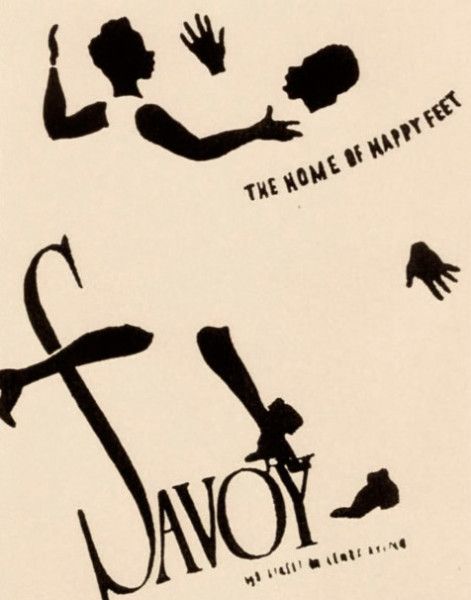
3. Which is the first trombone part you are aware of that goes below low ‘E’, and would require a trigger?
I believe Ellington’s first use of the bass trombone (as BASS trombone…below low ‘E’) to be on the album “Afro-Bossa” recorded and released for Reprise in 1963:
Low ‘D’ in “Moonbow”
Low ‘C’ in “Absinthe”
“Pyramid” has and interesting quasi-ostinato figure; Low ‘C’
Low ‘C’ Jam with Sam 1966 (Live (7/27/66-Cote D’Azur)
The Ella Fitzgerald & Duke Ellington Cote D’Azur Concerts On Verve
and he keeps getting lower…Low ‘B’ in “Afrique”, from The Afro-Eurasian Eclipse, recorded in 1971 and released on the Fantasy label in 1975
4. Do you think that Harry Carney’s incredible tenure with Duke Ellington predisposed Duke’s thinking of the Bari-sax as the bottom of the winds, and as his first consideration for a bass voice solo instrument?
I’m not sure Carney’s sound has a direct correlation to the “bass” sound in Ellington’s head, at least one that would relate to Ellington’s use of the bass trombone. “Agra” from the Far East Suite, Carney walks all the way down the instrument (Bari here), in a loud, gruff manner. Ellington never really uses Chuck (or Taylor) in that way.
5. When did Duke perform with tuba as opposed to string bass?
It seems that 1927 is the pivotal year that Ellington switches from tuba to bass. “East St. Louis Toodle-Oo”, Welman Braud plays tuba. In the very next recording, “Black and Tan Fantasy”, Braud is heard playing string bass. It is interesting to note that Duke is still using banjo here. While, in the minds of many, there is a link between banjo and tuba, Ellington and Braud can be credited with the innovation of using the double-bass rather than the tuba in jazz rhythm sections.”
Braud’s initial recording sessions with Duke were in October 26, 1927. In “Washington Wobble”, Braud takes a short pizz solo. Braud’s brief solos are important, because some historians maintain Bill Johnson’s solo on Johnny Dodd’s July 1928 “Bull Fiddle Blues” is the first recorded pizzicato jazz bass solo. Also, Braud has been characterized as a two-beat player, but he often played four-beat pizz walking style, such as the November 1928, Okeh recording of “Misty Mornin'”, which is both arco and four-beat style. On a November 3, 1927 recording of “Black and Tan Fantasy”, Braud switches from arco to pizzicato and back. For the March 1928 Victor session of “Black Beauty”, Braud utilizes double-time. On a November 1928 session, “I Can’t Give You Anything but Love” Braud recreates the tuba intro he played on an earlier version, but this time on bass.

6. Did you know Chuck Connors?
Chuck Connors was a friend of mine. Sometime, (I think it was 1991) I was in need of a bass trombone as I had hocked mine. I was put in touch with Chuck through a mutual friend who ran a big band in town (Pavilion Music Company), Marcus Ware. I called Chuck and he said to come on by and pick out a horn. He said I could borrow one as long as I needed! I drove to his house, then rang the bell…his wife (Betty I believe) answered the door. She told me that Chuck was at a doctor’s appointment and would return shortly. She showed me around their modest home. Hundreds of pictures hung on the wall; some family pictures and artwork, but mostly pictures of Chuck with members of the Ellington band, playing in the Ellington band, of him with celebrities, etc. Occasionally she would point and reminisce…at pictures of Chuck with “Diz”, Ellington, and Sammy Davis, Jr. I was star-struck.
Chuck returned. We continued to peruse the pictures on the wall and worked our way down some stairs to the basement. There were maybe twenty trombone cases strewn around the basement. He brought several closer to me and opened the cases: a Conn single-valve, a Bach 50B single-valve, a Remington Contempora single-valve, and one I can’t recall. He mentioned that he was playing a 50B double-valve lately and that any of these were mine for the choosing. I played on them all and opted for the Reynolds Contempora. I fell in love with this horn. I’ve seen several pictures of Chuck playing, or posing with this horn in his. It makes me smile every time. We stayed in touch. By the time I returned the horn, Chuck had past. I returned the horn to Betty. I don’t know what happened to that horn…but, my memories of Chuck reside permanently in the recesses of my mind. When I hear his sound, I am taken back to my youth in Cincinnati, Ohio where a man made an indelible impression on me as a musician and human being.
I believe my career was in part, shaped by the generosity of Chuck Connors. His sound, the Ellington Orchestra, his kindness and warmth as a person and musician – ELLINGTON – all played a role in shaping my career choices.
c. 2013 David William Brubeck All Rights Reserved davidbrubeck.com
****************************************************************************************************
Marc T. Bolin has performed with some of the world’s finest artists and organizations such as B.B. King, Dee Dee Bridgewater, Lalo Schifrin, Herman Olivera, Pete Escovedo, Sheila E, Black Eyed Peas, Deltron 3030, Aloe Black, and Stevie Wonder. He recently participated in a State Tour of China playing traditional Jazz, performed with the Ambassadors of New Orleans’ Jazz at the Red Sea Jazz Festival in Israel, has performed in two of Philip Glass’ Operas Akhenaton and La Belle et la Bete, and has even played on the Mississippi Riverboats. In 2007 Marc was commissioned to realize Duke Ellington’s incomplete opera “Queenie Pie” for the Oakland Opera Theater then in 2008 was invited to present his research and reflections in his paper Realizing the Duke at the Echoes of Ellington Conference at UT Austin. In addition to Oakland and UT Austin’s productions, both Long Beach Opera and Chicago Opera Theater will perform Queenie Pie in 2014.
COPYRIGHT NOTICE/DISCLAIMER
FAIR USE:
COPYRIGHT DISCLAIMER UNDER SECTION 107 OF THE COPYRIGHT ACT 1976,
ALLOWANCE IS MADE FOR “FAIR USE” FOR PURPOSES SUCH AS CRITICISM, COMMENT, NEWS REPORTING, TEACHING, SCHOLARSHIP AND RESEARCH.
FAIR USE IS PERMITTED BY COPYRIGHT STATUTE THAT MIGHT OTHERWISE BE INFRINGING. NON-PROFIT, EDUCATIONAL OR PERSONAL USE TIPS THE BALANCE IN FAVOR OF FAIR USE


